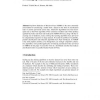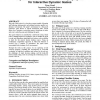233 search results - page 19 / 47 » Learning Decision Lists Using Homogeneous Rules |
ACL
1997
13 years 9 months ago
1997
Our goal is to identify the features that predict the occurrence and placement of discourse cues in tutorial explanations in order to aid in the automatic generation of explanatio...
GECCO
2010
Springer
13 years 9 months ago
2010
Springer
Most highly accurate predictive modeling techniques produce opaque models. When comprehensible models are required, rule extraction is sometimes used to generate a transparent mod...
IFIP12
2008
13 years 9 months ago
2008
Top Down Induction of Decision Trees (TDIDT) is the most commonly used method of constructing a model from a dataset in the form of classification rules to classify previously unse...
EUSFLAT
2003
13 years 9 months ago
2003
A typical task in technical fault detection or medical diagnosis problems is to discriminate normal behavior from one or more types of abnormal behavior by means of different meas...
GECCO
2008
Springer
13 years 9 months ago
2008
Springer
The goal of this project is to develop an agent capable of learning and behaving autonomously and making decisions quickly in a dynamic environment. The agent’s environment is a...


